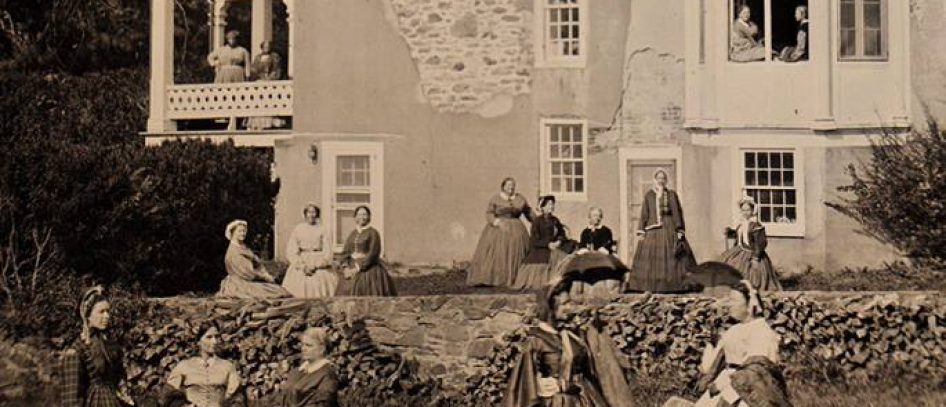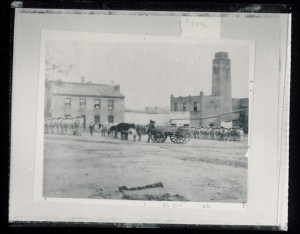For an extensive discussion on family assistance in Texas during the Civil War, see “A Sacred Charge Upon Our Hands: Assisting the Families of Confederate Soldiers in Texas, 1861-1865″ by Vicki Betts in The Seventh Star of the Confederacy: Texas during the Civil War, Kenneth W. Howell, editor.
In light of the food and cloth shortages, and the numerous families left behind when the men went to war, the state of Texas and its people attempted to set up systems to alleviate some of the suffering experienced by the poor. The state allocated $600,000 to be distributed to the counties for the aid of soldiers’ families and approved an increase in the ad valorem state tax as well as the institution of a special county war tax. In Bexar County, which includes San Antonio, five dollars were allowed the wife of a soldier in service and two dollars for the soldier’s children. Special allowances were made for widows, orphans, and payment of housing.
The Texas Legislature also authorized the distribution of 600,000 yards of cloth from the Penitentiary in Huntsville for the families of soldiers. More than 200 convicts turned out nearly 6,000 yards of osnaburg daily at the penitentiary. The cloth was used to clothe the convicts and state troops and the remainder was sold to the Confederate army, exchanged for supplies, distributed to soldiers’ families, given to other state agencies, or sold to the general public. Through sales both to the civilian population and to Confederate military units, gross earnings during the war exceeded $1 million of which approximately $800,000 was deposited in the state treasury as profit.1
In order for the wife of a Texas CSA soldier to received Penitentiary cloth, an affidavit was required before the county judge to verify that 1) it was for the use of her immediate family only, including black slaves, 2) that it would not be bartered, sold, or exchanged, and 3) she was indeed the wife of a Confederate soldier.
As early as 1862, citizens not members of a soldiers’ family were finding it difficult to get cloth from the Penitentiary. The Tri-Weekly Telegraph reported in October of 1862, “We learn from the Penitentiary that the applications for cloth are filled in the following order: first, the army; second, families of soldiers; and third, the people. At present there are unfilled requisitions for the service to a larger extent, and for 500 families of soldiers; and besides these 30,000 applications of the third class are awaiting their turn. People can see that the prospect of getting anything is very small.”2 Gideon Lincecum attempted to get cloth from Huntsville in July 1862 but “…there were so many people in [line] ahead of me that the superintendent told me that it would be five weeks before my turn could be supplied.”3 By 1864, cloth was no longer given for slaves and only 3 yards allowed for each white member of a soldier’s family. Eventually that year even the soldiers’ families were denied.
Some women did begin spinning and weaving to meet the clothing needs of their families. However, as with other manufactured goods, cards for carding wool and cotton were in short supply or nonexistent in Texas. Without the cards to prepare the fiber, no cloth could be woven. When cards did become available they were horrendously expensive rising in price from forty cents to over thirty dollars a pair.4 Gideon Lincecum wrote to the Galveston News “But the scarcity and ruinous high prices of the cards operates, with many poor families, as a sufficient barrier to prevent them from doing anything at all towards clothing themselves even.”5 By 1863 the military board was able to distribute some cards charging only $10.00 a pair; still a hefty sum of money and not every county received enough cards for their population.
Government aid not being enough, private help was called for. Newspapers pleaded with citizens to contribute to the aid of poor families. In response, aid societies and associations were organized in almost every county to assist the poor, particularly the families of soldiers. In 1862,Gideon Lincecum wrote about the relief committee in his town of Long Point, “…to take charge of and distribute to the outfit of the volunteers…and to the necessities of the needy wives and families of the absent volunteers, ample donations of corn, cotton, beeves, cows & calves, etc. subscribed by a portion of the patriotic citizens…which liberal donations have so far been carefully and prudently distributed by the said relief committee for the purposes intended; and there is a large amount still available on the subscription list…”6
In San Antonio and several other cities Mutual Aid Associations were established. The Galveston Weekly News describes such an association established in Victoria:
The Victoria Advocate says a Supply Association has been formed in that place, and hopes it may have the effect to knock the monopolists and extortioners [sic] into a “cocked hat.” Like associations are said to have afforded great relief in other places, as in San Antonio and Austin. We understand the Association to be on the principle of a joint stock company, whose object it is to import the necessaries of life from Mexico or elsewhere, so as to afford them to the stockholders at the lowest cost and charges, without having to pay two or three hundred per cent. profit to the speculator, while at the same time, the Association makes it a part of its business to afford relief to the extent of its power to those who are not able to take stock, by letting those have the articles also at cost and charges. …The San Antonio Herald of the 14th instant says: The San Antonio Supply Association is furnishing its members and the poor of this city with flour, corn meal, salt, sugar, &c., much cheaper than such articles can be purchased in any other portion of the State. It is selling flour at $16 per hundred pounds, about half the price it now brings at Dallas, where the Association purchased it.7
Mary Maverick visited the Mutual Aid store in San Antonio and wrote of her experience to her son in 1864:
Yesterday the long talked-of & looked-for goods were opened at the Mutual Aid store & all the town & all the county it seemed streamed in there….I went & stood wedged up swaying about till near 12 when I actually did get to the counter & had one of the numerous clerks’ attention long enough to get one bolt of domestic cloth, one pr shoes & 1 doz[en] candles for $180.00. Pa went this morning & understood the crowd to be greater–he got a coffee pot and 20 lbs of coffee for $85–most reasonable thing they had…Each purchaser is limited in a quantity in each article so that all the numerous shareholders get a chance at something. I must go after more shoes, & some thread–get only what is very needful. I suppose all will be gone before the week is…8
Private support was also raised in the form of various entertainments. Harriet Perry wrote to her husband Theophilus about one such entertainment in February 1864 “Charades on Tuesday night–there was a large attendance. They took in about a thousand dollars. Admission fee two dollars.”9
1 Handbook of Texas Online, s.v. “Texas State Penitentiary in Huntsville,” http://www.tshaonline.org/handbook/online/articles/TT/jjt1.html (accessed December 6, 2009).
2 Tri-Weekly Telegraph. October 3, 1862, page 2 column 3
3 Lincecum, Jerry Bryan. Gideon Lincecum’s Sword. University of North Texas Press, 2001, page 194-195
4 Ibid, page 197 footnote
5 Ibid, page 212
6 Ibid, page 190
7 Galveston Weekly News. March 4, 1863, page 1 column 2
8 Marks, Paula Mitchell, ed. When Will the Weary War Be Over? The Civil War Letters of the Maverick Family of San Antonio. Book Club of Texas, Dallas, page 100-101
9 Johansson, M. Jane. Widows by the Thousand: The Civil War Letters of Theophilus and Harriet Perry 1862-1864. University of Arkansas Press, 2000, page 44

